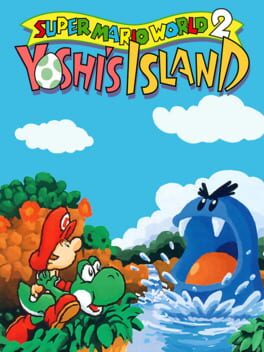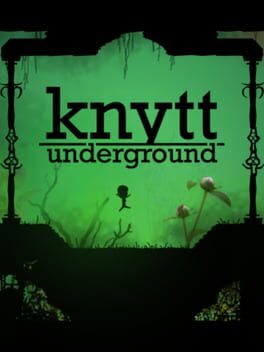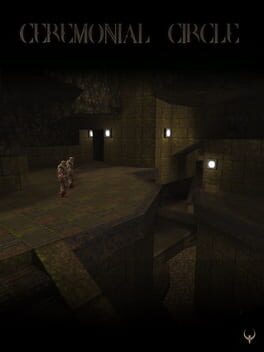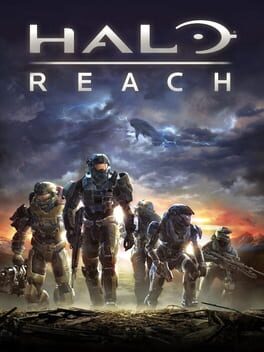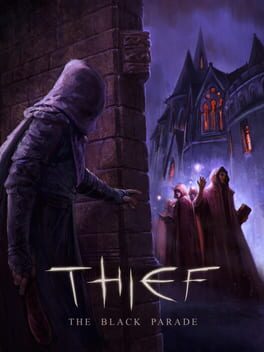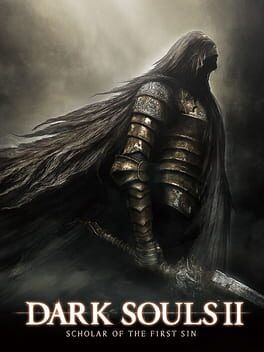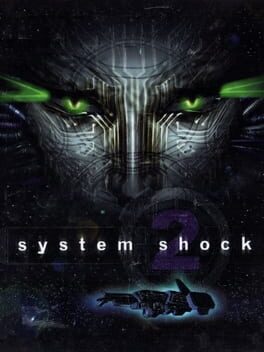While I wouldn't call Yoshi's Island one of my favorite platformers, I certainly wouldn't bat an eye at the many who do. Yoshi's moveset is fairly complex, and the level design built around it is consistently inventive throughout the game's six worlds. I'm less convinced of the need for the need for, say, Yoshi's helicopter powerup or super baby Mario than Mario's various suits and hats in the older Mario games, but it's not a huge issue. The much-derided crying Mario "health" mechanic is one of the game's bigger strokes of core design success, providing leeway for mistakes in a way that's a bit more interesting—and less punishing—than in earlier Mario games, while still enforcing a degree of consistency and quick, smart responses from the player. If the level themes get a little repetitive at times, the art and especially the backgrounds are consistently beautiful. Whether it's the best-looking Mario game probably comes down to personal aesthetic preference (there's something to be said for the constrained strangeness of the NES visuals, especially in SMB3), it's certainly the most impressively detailed.
My biggest gripe with the game come down to the persistence of arcade-style design conventions (coin collecting, limited lives, etc). While I don't have any issue with these conventions per se, provided they are smartly integrated into the game design as a whole, here they feel almost vestigial. It smarts especially when the reward for unlocking a semi-hidden door turns out to be a slot machine minigame. This stuff feels strange in an otherwise (relatively) slow-paced, exploratory game, and gets at why my favorite SNES games tend to be the ones that abandon these conventions in favor of something else. Then again, the games I'm thinking of have direct antecedents back on the NES which I've never played, so back to gamer college for me I guess?
My biggest gripe with the game come down to the persistence of arcade-style design conventions (coin collecting, limited lives, etc). While I don't have any issue with these conventions per se, provided they are smartly integrated into the game design as a whole, here they feel almost vestigial. It smarts especially when the reward for unlocking a semi-hidden door turns out to be a slot machine minigame. This stuff feels strange in an otherwise (relatively) slow-paced, exploratory game, and gets at why my favorite SNES games tend to be the ones that abandon these conventions in favor of something else. Then again, the games I'm thinking of have direct antecedents back on the NES which I've never played, so back to gamer college for me I guess?
2004
This is not a review so much as a brief commentary or analysis of a certain aspect of Yume Nikki I find interesting. I have no intention of providing the (n+1)th narrative interpretation of the game's imagery etc.
--
A large subset of "art games" (a term I dislike, but I won't go into that here) turn on the central act of moving through space. While derisive commentary on such games generally draws attention to the lack of interactivity between the player and environment, I find it more interesting and helpful to think about the ways in which these games allow movement to be expressive, or how they fail to do so.
In a certain sense many, if not most, games already have movement at their core, and arguably handle it more profoundly than many art games by complicating and problematizing the nature of movement itself. One trick is to split movement into distinct actions (jumping, walking, dashing, etc.) which are required in different combinations at different times; another is to confront the player with AI agents ("enemies") that impede the player's movements unless they are avoided or overcome. If this is obvious, the point is that these complexities make the act of movement itself expressive in ways that are easy to forget when everything is viewed abstractly in terms of genre conventions.
The question is, when such things (whether we insist on calling them "gameplay" or not) are subtracted, what is left to be expressive? Many authors will rely on the strength of their writing or art, and this approach can be fruitful, but it sidesteps the question I'm interested in. Yume Nikki answers this challenge with the very structure of space itself.
Partly it does so by drawing on the conventions of a kind of game that predates digital games, i.e. the maze. Even putting aside its scale and interconnectedness (and the occasional gate puzzle), Yume Nikki is a particularly forbidding maze in that it has no end, at least in the usual sense. The "effects" scattered throughout its interior (some of which aid traversal while others are purely cosmetic) unlock an ending, true, but many of Yume Nikki's depths contain no effects at all. The game's world is many times larger than it needs to be to accommodate the effect-finding game. Certainly, each "unnecessary" area serves its own narrative or affective purpose, but in terms of my argument they all serve just one: they are places to be lost in.
The other, complimentary aspect of Yume Nikki's approach is its austerity. Yume Nikki has no concern for making a first impression of variety or density; looking at the areas immediately accessible from the Nexus, the impression is rather one of emptiness. Partly it's the repeating tiles, a technical convention of RPGMaker and the games it draws from, but also the scarcity of features, interactive or otherwise, that would distract the eyes or hands in the way we normally expect.
The upshot is that Yume Nikki requires two things of its players: firstly, not to become bored (something of a dare in all honesty), and secondly to be quite deliberate and systematic in their approach to exploration. All this results in a level of serious engagement the typical "walking sim" does not require, and in the long run that other aspect—Yume Nikki's art and aesthetics—only gains from this.
Notes:
1. One could reasonably argue that much of what I have said about Yume Nikki's structure derives from its unfinished state. While I doubt an updated version would drastically alter this structure by filling in currently "empty" areas, I'll concede that I have nothing to base this on besides intuition, and that other additions or alternations could change the core in unforeseen ways. (That is, of course, assuming the project has not been abandoned.)
2. I will also concede that certain secrets are definitely /too/ well-hidden.
--
A large subset of "art games" (a term I dislike, but I won't go into that here) turn on the central act of moving through space. While derisive commentary on such games generally draws attention to the lack of interactivity between the player and environment, I find it more interesting and helpful to think about the ways in which these games allow movement to be expressive, or how they fail to do so.
In a certain sense many, if not most, games already have movement at their core, and arguably handle it more profoundly than many art games by complicating and problematizing the nature of movement itself. One trick is to split movement into distinct actions (jumping, walking, dashing, etc.) which are required in different combinations at different times; another is to confront the player with AI agents ("enemies") that impede the player's movements unless they are avoided or overcome. If this is obvious, the point is that these complexities make the act of movement itself expressive in ways that are easy to forget when everything is viewed abstractly in terms of genre conventions.
The question is, when such things (whether we insist on calling them "gameplay" or not) are subtracted, what is left to be expressive? Many authors will rely on the strength of their writing or art, and this approach can be fruitful, but it sidesteps the question I'm interested in. Yume Nikki answers this challenge with the very structure of space itself.
Partly it does so by drawing on the conventions of a kind of game that predates digital games, i.e. the maze. Even putting aside its scale and interconnectedness (and the occasional gate puzzle), Yume Nikki is a particularly forbidding maze in that it has no end, at least in the usual sense. The "effects" scattered throughout its interior (some of which aid traversal while others are purely cosmetic) unlock an ending, true, but many of Yume Nikki's depths contain no effects at all. The game's world is many times larger than it needs to be to accommodate the effect-finding game. Certainly, each "unnecessary" area serves its own narrative or affective purpose, but in terms of my argument they all serve just one: they are places to be lost in.
The other, complimentary aspect of Yume Nikki's approach is its austerity. Yume Nikki has no concern for making a first impression of variety or density; looking at the areas immediately accessible from the Nexus, the impression is rather one of emptiness. Partly it's the repeating tiles, a technical convention of RPGMaker and the games it draws from, but also the scarcity of features, interactive or otherwise, that would distract the eyes or hands in the way we normally expect.
The upshot is that Yume Nikki requires two things of its players: firstly, not to become bored (something of a dare in all honesty), and secondly to be quite deliberate and systematic in their approach to exploration. All this results in a level of serious engagement the typical "walking sim" does not require, and in the long run that other aspect—Yume Nikki's art and aesthetics—only gains from this.
Notes:
1. One could reasonably argue that much of what I have said about Yume Nikki's structure derives from its unfinished state. While I doubt an updated version would drastically alter this structure by filling in currently "empty" areas, I'll concede that I have nothing to base this on besides intuition, and that other additions or alternations could change the core in unforeseen ways. (That is, of course, assuming the project has not been abandoned.)
2. I will also concede that certain secrets are definitely /too/ well-hidden.
2012
On paper, this is absolutely what I wanted from a sequel to the original Knytt—the same format, tapping into the intrinsic pleasure of wandering with no other purpose than to see what's around the next corner, over the next hill, on the next screen—but in an even bigger world this time. And the new, more sombre but still very colorful graphical style is an interesting step from Nifflas's earlier games.
But I have to admit I really dislike the platforming here, which is a shame because the game places a much greater emphasis on platfoming challenges compared to the earlier Knytt titles. There are hints of this in Knytt Stories (even putting aside Kaizo Knytt stuff), not to mention Within a Deep Forest (which has its advocates, though I never got into it myself). Bouncing ball mode is the main culprit here: I just find it impossible to control it with any degree of precision. Who knows, maybe proficiency and even mastery is totally possible and I just suck. If that's the case I'm willing to live with that.
But I do enjoy putting this on and wandering around for a half hour every now and again, and that's worth something.
But I have to admit I really dislike the platforming here, which is a shame because the game places a much greater emphasis on platfoming challenges compared to the earlier Knytt titles. There are hints of this in Knytt Stories (even putting aside Kaizo Knytt stuff), not to mention Within a Deep Forest (which has its advocates, though I never got into it myself). Bouncing ball mode is the main culprit here: I just find it impossible to control it with any degree of precision. Who knows, maybe proficiency and even mastery is totally possible and I just suck. If that's the case I'm willing to live with that.
But I do enjoy putting this on and wandering around for a half hour every now and again, and that's worth something.
2010
As good as I was expecting given the seven-year development time and the pedigree of the development team (a virtual who's who of the current crop of Thief fan mission authors), which is just insanely good.
The campaign continues my favorite trends in Thief custom level design (high levels of verticality; rehabilitation of the less... popular themes that characterize Thief: The Dark Project levels, namely supernatural horror) while bucking the older habits endemic to fan missions that target the "hardcore" set (obtuse riddles and key item hunts). Thankfully.
Before this I'd have pointed to the 20th Anniversary contests as the ideal entry point to what is, in my opinion, one of the single greatest PC game modding scenes of all time. Now I'd point to The Black Parade for the second and fourth missions alone (respectively the best Constantine's mansion and Bonehoard-style missions out there, and I've played all the good ones).
Bust out your black hoodies and diegetic compass/map combos, folks. This is IT.
The campaign continues my favorite trends in Thief custom level design (high levels of verticality; rehabilitation of the less... popular themes that characterize Thief: The Dark Project levels, namely supernatural horror) while bucking the older habits endemic to fan missions that target the "hardcore" set (obtuse riddles and key item hunts). Thankfully.
Before this I'd have pointed to the 20th Anniversary contests as the ideal entry point to what is, in my opinion, one of the single greatest PC game modding scenes of all time. Now I'd point to The Black Parade for the second and fourth missions alone (respectively the best Constantine's mansion and Bonehoard-style missions out there, and I've played all the good ones).
Bust out your black hoodies and diegetic compass/map combos, folks. This is IT.
1999
In designing System Shock and Thief: The Dark Project, Looking Glass Studios aimed to achieve a "role-playing" experience that was quite different from videogames that drew their mechanics directly from tabletop RPGs. A key insight was that much of the arithmetic that in a tabletop environment might burden players and DMs alike could, in a digital environment, be handled more or less exclusively by the computer. A certain minimum of numerical awareness on the player's part is still necessary (health, ammo, etc), but there is simply no need for the usual RPG rube goldberg machine of having to do things to cause some numbers to go up to get some other numbers to go up in order to get the numbers you actually want to go up to go up.... Far more elegant approaches to player progression are now possible, and what Looking Glass achieved with System Shock—progression based on collecting equipment and suit upgrades—converges onto territory analogous to what Jeremy Parish charts in the transition from the console action-RPG to the metroidvania.
True, SS2's leveling system (by another name) is not exactly the sadly familiar contraption described above, but there is still a diegetically nonsensical experience currency that muddies the intuition driving the equipment-based elegance of SS1. True, grinding is not possible, but like all RPGs even with grinding, the whole system progressively locks the player out of options as the game advances, which by a sleight of hand is disguised as "choice." It is expressive enough that I may choose which weapons to fill my limited inventory space with, attending to the limitations imposed by the available resources (ammo, energy, etc), without forcing me to put points into a skill tree to use them effectively, or at all.
I'm admittedly being perverse in framing the benefit of such systems as a disadvantage when it's really a tradeoff: these systems allow for distinct paths of player character growth which, to be meaningful, must be mutually exclusive. That's nice. I prefer it the other way. ¯\(ツ)/¯
True, SS2's leveling system (by another name) is not exactly the sadly familiar contraption described above, but there is still a diegetically nonsensical experience currency that muddies the intuition driving the equipment-based elegance of SS1. True, grinding is not possible, but like all RPGs even with grinding, the whole system progressively locks the player out of options as the game advances, which by a sleight of hand is disguised as "choice." It is expressive enough that I may choose which weapons to fill my limited inventory space with, attending to the limitations imposed by the available resources (ammo, energy, etc), without forcing me to put points into a skill tree to use them effectively, or at all.
I'm admittedly being perverse in framing the benefit of such systems as a disadvantage when it's really a tradeoff: these systems allow for distinct paths of player character growth which, to be meaningful, must be mutually exclusive. That's nice. I prefer it the other way. ¯\(ツ)/¯
